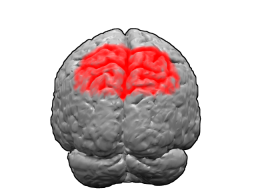Brodmann area 7
Brodmann area 7 is one of the cytoarchitectonic regions of the brain identified by the German anatomist Korbinian Brodmann in the early 20th century. It is located in the parietal lobe, posterior to the primary somatosensory cortex (Brodmann area 3), and is involved in a variety of functions, including visuospatial processing, proprioception, and self-awareness.
Anatomy[edit | edit source]
Brodmann area 7 is located in the parietal lobe, occupying a large portion of the superior and lateral surfaces of the lobe. It is bounded anteriorly by Brodmann area 3, posteriorly by Brodmann area 39, and inferiorly by Brodmann area 40. The area is divided into two subregions, 7a and 7b, with 7a located on the superior surface and 7b on the lateral surface.
Function[edit | edit source]
Brodmann area 7 plays a crucial role in integrating sensory information from various modalities to form a coherent representation of the body and the world around it. It is particularly involved in visuospatial processing, which allows us to perceive and interpret spatial relationships among objects. This area is also implicated in proprioception, the sense of the relative position of one's own parts of the body and strength of effort being employed in movement.
In addition to these sensory functions, Brodmann area 7 is also involved in self-awareness. Studies have shown that damage to this area can result in anosognosia, a condition in which a person is unaware of their own physical impairments.
Clinical significance[edit | edit source]
Damage to Brodmann area 7 can result in a variety of neurological and psychiatric conditions. These include Balint's syndrome, a disorder characterized by inability to perceive the visual field as a whole; Gerstmann's syndrome, a neurological disorder marked by a constellation of symptoms including finger agnosia and left-right disorientation; and somatoparaphrenia, a delusion where one denies ownership of a limb or an entire side of one's body.
See also[edit | edit source]
References[edit | edit source]
External links[edit | edit source]
- Brodmann area 7 at BrainInfo
Search WikiMD
Ad.Tired of being Overweight? Try W8MD's physician weight loss program.
Semaglutide (Ozempic / Wegovy and Tirzepatide (Mounjaro / Zepbound) available.
Advertise on WikiMD
|
WikiMD's Wellness Encyclopedia |
| Let Food Be Thy Medicine Medicine Thy Food - Hippocrates |
Translate this page: - East Asian
中文,
日本,
한국어,
South Asian
हिन्दी,
தமிழ்,
తెలుగు,
Urdu,
ಕನ್ನಡ,
Southeast Asian
Indonesian,
Vietnamese,
Thai,
မြန်မာဘာသာ,
বাংলা
European
español,
Deutsch,
français,
Greek,
português do Brasil,
polski,
română,
русский,
Nederlands,
norsk,
svenska,
suomi,
Italian
Middle Eastern & African
عربى,
Turkish,
Persian,
Hebrew,
Afrikaans,
isiZulu,
Kiswahili,
Other
Bulgarian,
Hungarian,
Czech,
Swedish,
മലയാളം,
मराठी,
ਪੰਜਾਬੀ,
ગુજરાતી,
Portuguese,
Ukrainian
Medical Disclaimer: WikiMD is not a substitute for professional medical advice. The information on WikiMD is provided as an information resource only, may be incorrect, outdated or misleading, and is not to be used or relied on for any diagnostic or treatment purposes. Please consult your health care provider before making any healthcare decisions or for guidance about a specific medical condition. WikiMD expressly disclaims responsibility, and shall have no liability, for any damages, loss, injury, or liability whatsoever suffered as a result of your reliance on the information contained in this site. By visiting this site you agree to the foregoing terms and conditions, which may from time to time be changed or supplemented by WikiMD. If you do not agree to the foregoing terms and conditions, you should not enter or use this site. See full disclaimer.
Credits:Most images are courtesy of Wikimedia commons, and templates, categories Wikipedia, licensed under CC BY SA or similar.
Contributors: Prab R. Tumpati, MD

